Do not hesitate to give us a call. We are here to help, before, during, and even after your trip.
+977 9851410929
info@nepaladventuretrail.com
EXCELLENTTrustindex verifies that the original source of the review is Google. Our travel with Nepal Adventure Trail was outstanding. Porgi was the best guide one could ask for. And the way we experienced Tibet as a family was one of our favorite trips ever. I would highly recommend this company for the full experience of traveling in Tibet. David U.S.A.Posted onTrustindex verifies that the original source of the review is Google. I went to Nepal with two of my sons, and the 12-day trip organized by Nepal Adventure Trail was absolutely fantastic. The itinerary was diverse and well-balanced, including guided tours of Kathmandu and Pokhara, a thrilling jungle safari on foot in Chitwan, and a breathtaking 3-day trek to the Australian Camp in the Himalayas. We were fortunate to have two superb guides, one for Kathmandu and Chitwan, and another for Pokhara and the trek. Both of them were knowledgeable, friendly, and attentive. This journey left us deeply impressed and eager to return to Nepal. Highly recommended!Posted onTrustindex verifies that the original source of the review is Google. Хорошая компания исполняющая взятые на себя обязательства. Путешествовать с ними большое удовольствие!Posted onTrustindex verifies that the original source of the review is Google. I have had a long standing business relationship with the team at Nepal Adventure Trail. A very porfessional company that offers a wide range of tourism services. I highly recommend them for planning and executing unique itineraries.Posted onTrustindex verifies that the original source of the review is Google. Nepal Adventure Trail is one of the best companies I’ve ever worked with. We had an incredible experience with this trail, During our trip to Annapurna Base Camp on April-May, 2025. Very good experience, robust knowledge and friendly staff who helped us every aspect of our journey and mission. Mr. Sapkota, pragya & his entire team is dedicated and very professional. I would strongly recommend that if you’re interested doing something interesting like Hiking, trekking or exploring nature of virgin mountain, please go ahead with this company.Posted onTrustindex verifies that the original source of the review is Google. Amazing EBC trek was organised by Nepal Adventure Trail for us (a group of friends from London) in March 2025. As you can imagine, when there are 8 individuals, 16 different ideas pop ups and the company was accommodating our changes while going through such as change from standard route to Cho La Pass and via Gokyo Lake, arranging helicopter ride back Kathmandu and getting refund to airline ticket from Lukla.... It was an once in lifetime achievement for me and thanks for making my dream true and helping on the way through.Posted onTrustindex verifies that the original source of the review is Google. My wife, our friends, and I had the most unforgettable adventure trip to Mustang, Nepal last year, and it was all thanks to the exceptional organization and accompaniment of Nepal Adventure Trail. This company truly delivered everything they promised, seamlessly blending adventure, comfort and exploration. The 12 days itinerary was perfectly crafted, utilizing jeeps which allowed us to cover significant ground and witness the breathtaking landscapes of the region. The inclusion of a thrilling short rafting experience and hiking added exciting dimension to our trip. What truly set Nepal Adventure Trail apart was their incredible team. Our guide Progi and drivers were not just professionals, they were passionate, knowledgeable, and genuinely cared about ensuring every member of our group of 9 had a safe, enjoyable and enriching journey. They handled all logistics with remarkable efficiency, from accommodations to meals. Their local insights brought the history, culture and traditions of Nepal and specifically Mustang region to life, making every stop more meaningful. If you are planning a trip to Nepal, especially an adventure like exploring Mustang, I would definitely recommend Nepal Adventure Trail. They go above and beyond to create personalized and memorable travel experiences.Posted onTrustindex verifies that the original source of the review is Google. We had an unforgettable experience combining the Mustang Jeep Tour with the Ghorepani Trek, all arranged by Nepal Adventure Trail. The contrast between the rugged Mustang landscapes and the lush forests of Ghorepani was simply breathtaking. Everything was perfectly managed—from the comfy jeep rides to the peaceful mountain lodges. Our guide was knowledgeable, friendly, and made us feel safe and inspired every step of the way. Truly a once-in-a-lifetime journey!Posted onTrustindex verifies that the original source of the review is Google. Progi is excellent guide and travel organizer!!! We traveled with him twice and have a very good service!Posted onTrustindex verifies that the original source of the review is Google. Progi guided my group to Muktinath and was a thoughtful, considerate and knowledgeable guide. He was able to cater to all the diverse needs of the group expertly and always with a smile.Verified by TrustindexTrustindex verified badge is the Universal Symbol of Trust. Only the greatest companies can get the verified badge who has a review score above 4.5, based on customer reviews over the past 12 months. Read more

Island Peak, also known as Imja Tse, is a beacon of adventure in Nepal’s Khumbu region. This island peak height and island peak elevation of 6,189 meters make it a gateway to the world of mountaineering, offering an exhilarating journey through the heart of the island peak Himalayas. Whether you’re searching for “island peak nepal,” “island peak climb,” or “climbing island peak nepal,” this guide will prepare you for the island peak expedition.
First climbed in 1953 as a training peak for Everest, Island Peak in nepal got its name from its island-like appearance amidst glaciers when viewed from Dingboche. It’s an accessible yet challenging peak, ideal for both seasoned climbers and those embarking on their first island peak summit. Beyond the climb, the journey immerses you in Sherpa culture, with stops at vibrant villages and monasteries.

Island Peak Imja Tse blends trekking and technical climbing, perfect for adventurers looking to push their limits. The route offers stunning views of Everest (8,848m), Lhotse (8,516m), Nuptse (7,861m), and Makalu (8,485m). Many choose to combine it with the island peak climbing with EBC for a fuller Himalayan experience. You’ll trek through Sherpa villages like Namche Bazaar and Tengboche, gaining cultural insights alongside physical challenges. With a success rate of about 85% when properly acclimatized, it’s a rewarding yet achievable goal for those new to high-altitude climbing.
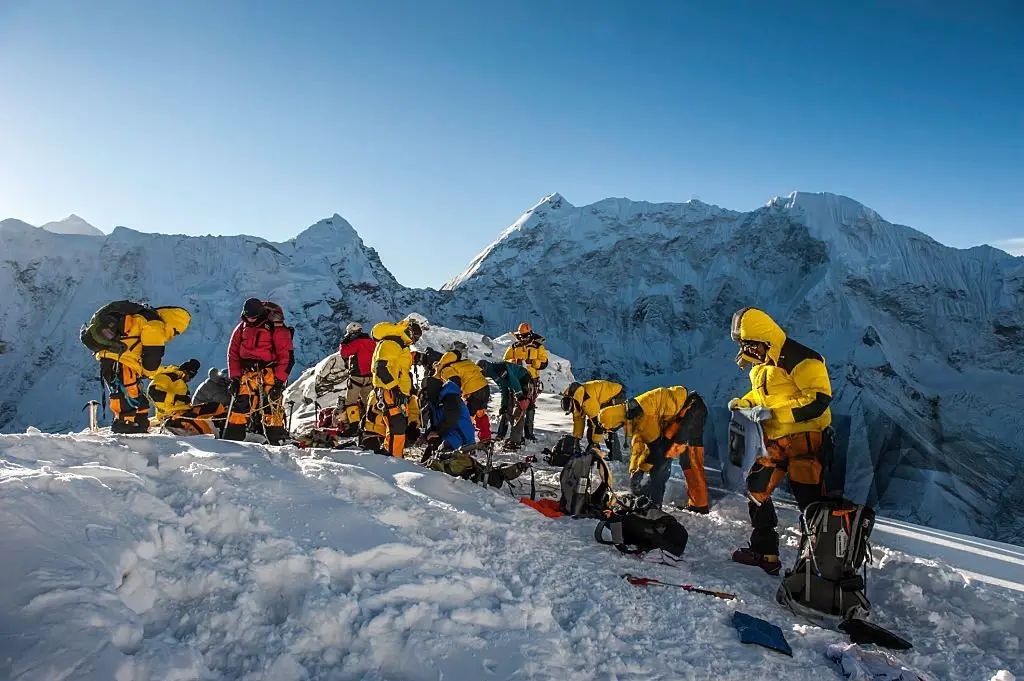
Preparing for an island peak climb demands physical, mental, and logistical readiness. Start training 3-6 months in advance to tackle the high-altitude and technical demands.
High-altitude climbing tests mental resilience. Practice mindfulness or meditation, visualize success, and set training milestones. Join forums for Nepal Island Peak climbers to connect and stay motivated. Trust your guides and training to navigate challenges like fatigue or weather shifts.
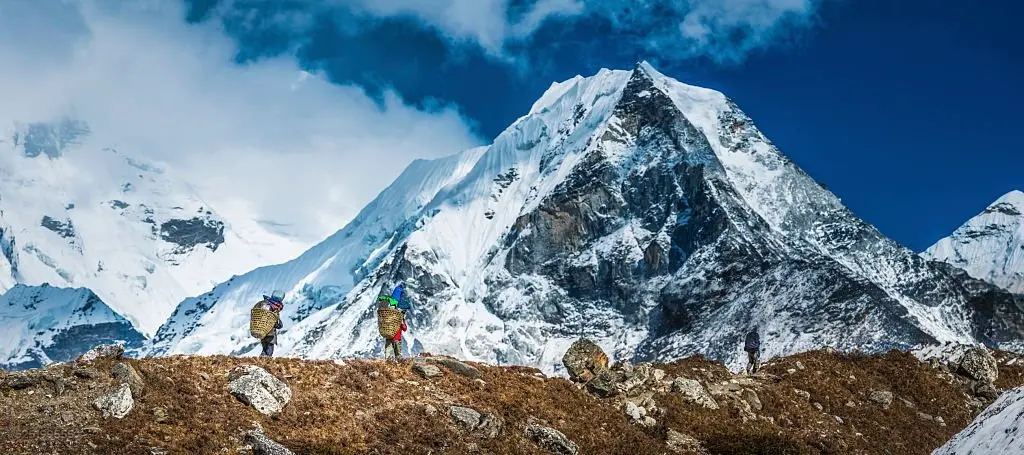
Proper acclimatization prevents altitude sickness during your Island Peak expedition. Ascend no more than 500m daily above 3,000m, with rest days every 3-4 days. Stay hydrated (4-5 liters daily), eat high-calorie meals, and avoid alcohol/smoking. Watch for Acute Mountain Sickness (AMS) symptoms like headaches or nausea—descend if severe. Experienced guides monitor oxygen levels and carry emergency oxygen. Island peak deaths are rare but highlight the need for preparation; most incidents stem from poor acclimatization or health issues.
Climb in spring (March-May) or autumn (September-November) for stable weather and clear views. Avoid the monsoon (June-August) and winter (December-February) due to rain or extreme cold. Permits include Sagarmatha National Park Entry ($30), Khumbu Pasang Lhamu Rural Municipality Fee ($20), Island Peak Climbing Permit ($250 in peak seasons), and a TIMS card. Guided trips cost $2,000-$4,000, covering logistics.
This extended itinerary for the Everest Base Camp trek with Island Peak climbing ensures acclimatization and a richer experience:

Summit day starts at 1-2 AM from High Camp to avoid afternoon winds. You’ll navigate a glacier, a steep headwall with fixed ropes, and a narrow ridge, taking 6-8 hours to ascend and 3-4 hours to descend. Expect cold (-10°C to -20°C) and thin air. Pace yourself, use a jumar for safety, and follow your guide. The island peak summit offers unmatched views of Everest and peaks. Top tips: eat well, layer clothing, stay hydrated, and prioritize safety if the weather worsens.
Ready for your new island peak adventure? Book with trusted operators and conquer the Himalayas!
 Accommodation & Meals
Accommodation & Meals Permits & Documentation
Permits & Documentation
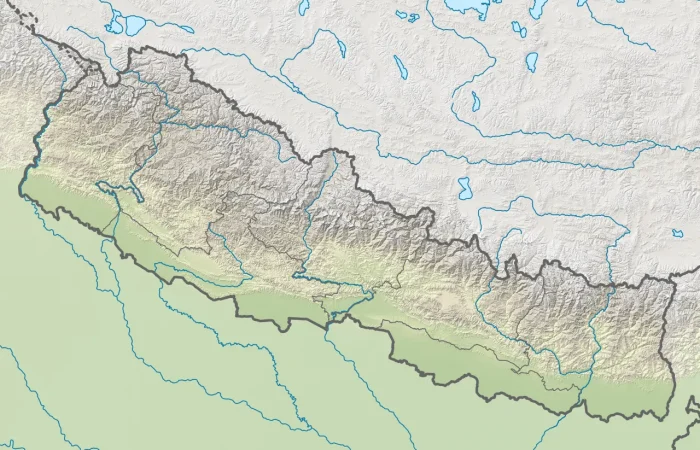
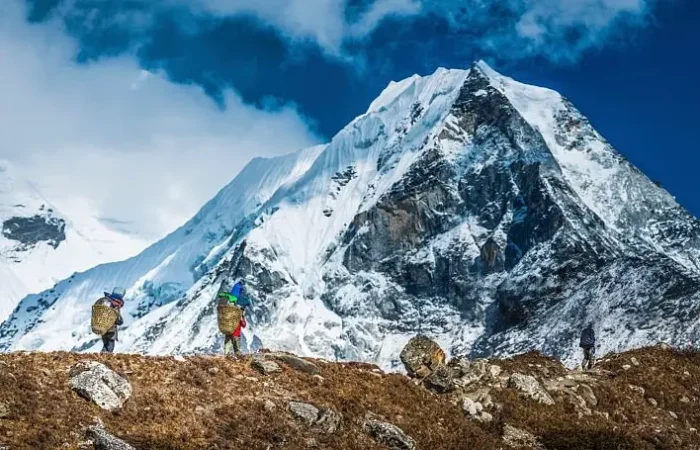

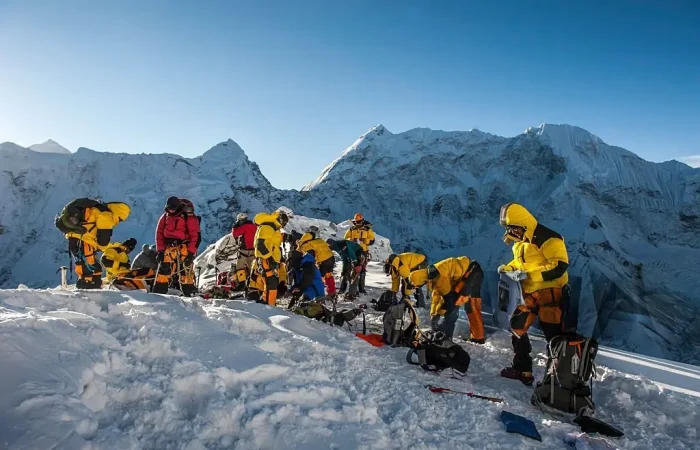
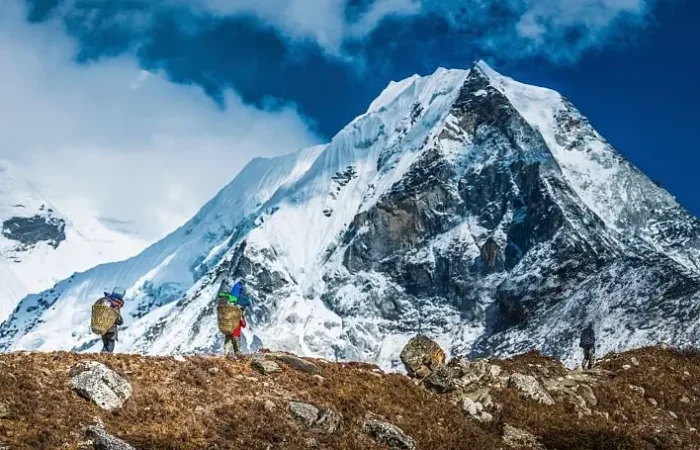
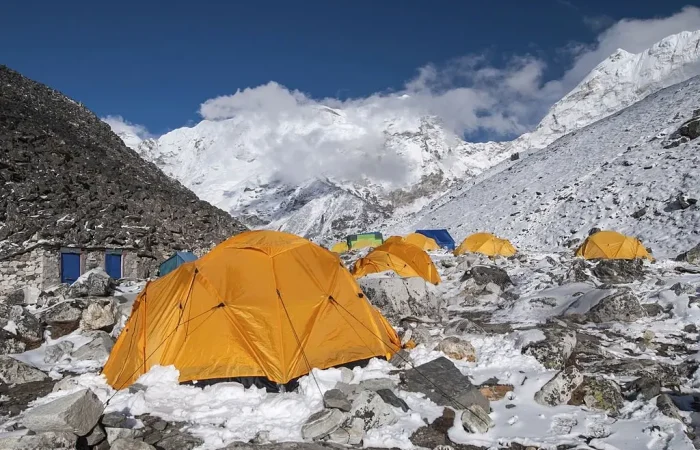
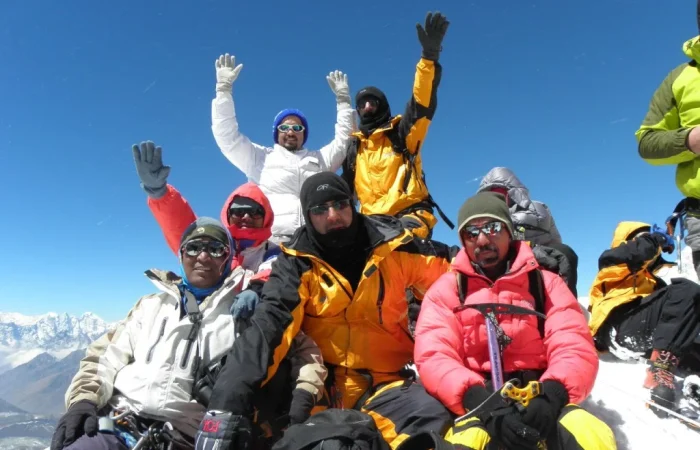



• Pass Pangboche village and beautiful mountain scenery.
• Hike to Nangkartshang Peak (5,083m) for acclimatization.
• Transfer to the airport for your flight home.
Island Peak, locally known as Imja Tse, stands at 6,189 meters (20,305 feet). It is located in the Khumbu Region of Nepal, near the Everest Base Camp, and is part of the Sagarmatha National Park.
Eric Shipton’s team gave the name “Island Peak” in 1953 because it appears like an island in a sea of ice when viewed from Dingboche.
Island Peak is considered a moderate to challenging climb. It is technically easier than the big Himalayan peaks but requires basic mountaineering skills such as using crampons, ice axes, and fixed ropes. The steep glacier climb and narrow summit ridge make it physically demanding.
While previous climbing experience is not mandatory, it is highly recommended. Familiarity with mountaineering techniques and trekking at high altitudes improves your chances of success. Island Peak is often used as a training climb for higher peaks like Everest or Ama Dablam.
The best seasons are:
Avoid climbing during the monsoon (June-August) and winter (December-February) due to unstable weather.
You will need the following permits:
These permits are usually arranged by your trekking agency.
The standard itinerary is 18 days, which includes trekking to and from the Khumbu region, acclimatization days, and the summit attempt. Some itineraries can be shortened to 16 days but may increase the risk of altitude sickness due to less acclimatization time.
A typical 18-day itinerary includes:
The exact itinerary can vary depending on the operator or group preferences.
Yes, altitude sickness is a potential risk due to the high elevation. To minimize it:
A good itinerary includes acclimatization days and a gradual ascent.
Climbing Island Peak requires a good level of physical fitness. You should be able to:
Cardio training, strength building (especially legs), and endurance exercises are recommended before the trip.
Essential gear includes:
A detailed gear checklist is provided by your agency.
Weather conditions vary:
Summit day is usually very cold, with temperatures dropping significantly
While solo trekking is allowed in Nepal, solo climbing on Island Peak is not recommended due to safety concerns and the technical nature of the climb. It’s better to join a guided expedition or a group.
The cost ranges from $2,000 to $3,500 USD, depending on the trekking company, group size, and services included. The price typically covers:
Teahouses offer a variety of meals, including:
At Base Camp, meals are simpler but sufficient for high-energy needs.
Yes, travel insurance is mandatory. It must cover:
Ensure your policy includes all potential risks associated with mountaineering.
Island Peak is ideal for trekkers transitioning into mountaineering. However, it is not a “beginner” peak in terms of ease. Basic climbing skills and prior trekking experience are highly beneficial.
Yes, Island Peak is often combined with:
Guides and porters are highly recommended for safety and convenience. Guides assist with navigation, climbing techniques, and weather monitoring, while porters carry heavy gear, reducing your physical burden.
Island Peak is relatively safe if climbed with proper preparation, acclimatization, and guidance. However, risks include:
A professional guide ensures your safety during the climb.
If you cannot summit due to weather, health, or other reasons, the guide will prioritize your safety and either descend or wait if conditions improve. The summit is never guaranteed, but contingency plans are in place.